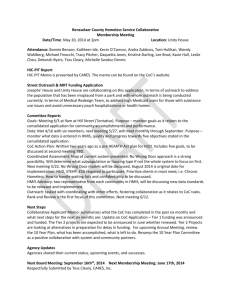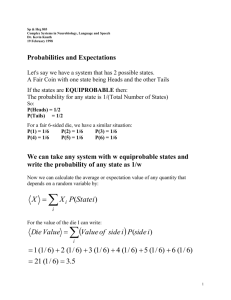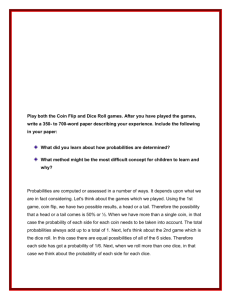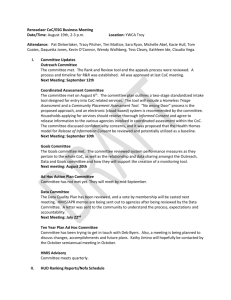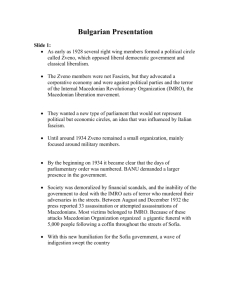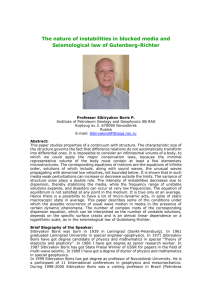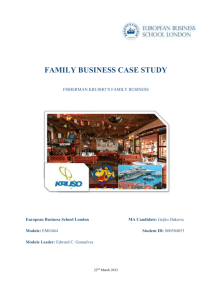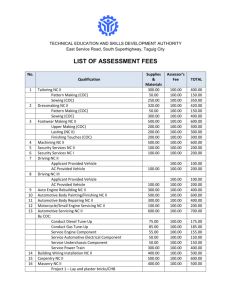quiz2
advertisement
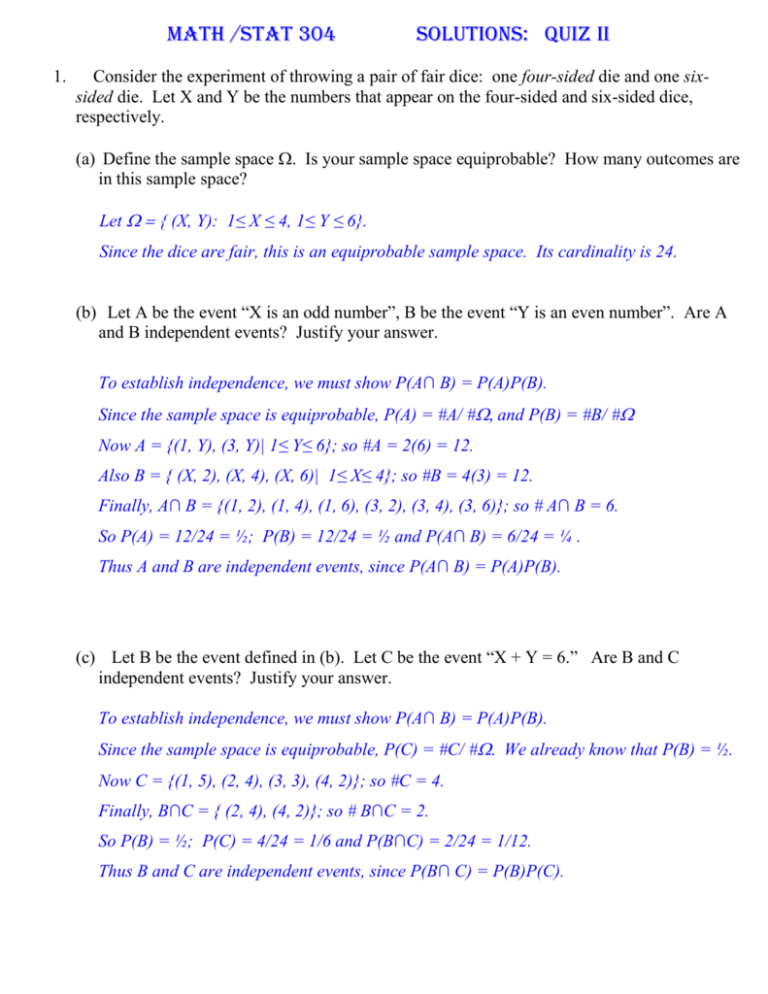
MATH /stat 304
1.
solutions: QUIZ II
Consider the experiment of throwing a pair of fair dice: one four-sided die and one sixsided die. Let X and Y be the numbers that appear on the four-sided and six-sided dice,
respectively.
(a) Define the sample space . Is your sample space equiprobable? How many outcomes are
in this sample space?
Let (X, Y): 1≤ X ≤ 4, 1≤ Y ≤ 6}.
Since the dice are fair, this is an equiprobable sample space. Its cardinality is 24.
(b) Let A be the event “X is an odd number”, B be the event “Y is an even number”. Are A
and B independent events? Justify your answer.
To establish independence, we must show P(A∩ B) = P(A)P(B).
Since the sample space is equiprobable, P(A) = #A/ #and P(B) = #B/ #
Now A = {(1, Y), (3, Y)| 1≤ Y≤ 6}; so #A = 2(6) = 12.
Also B = { (X, 2), (X, 4), (X, 6)| 1≤ X≤ 4}; so #B = 4(3) = 12.
Finally, A∩ B = {(1, 2), (1, 4), (1, 6), (3, 2), (3, 4), (3, 6)}; so # A∩ B = 6.
So P(A) = 12/24 = ½; P(B) = 12/24 = ½ and P(A∩ B) = 6/24 = ¼ .
Thus A and B are independent events, since P(A∩ B) = P(A)P(B).
(c) Let B be the event defined in (b). Let C be the event “X + Y = 6.” Are B and C
independent events? Justify your answer.
To establish independence, we must show P(A∩ B) = P(A)P(B).
Since the sample space is equiprobable, P(C) = #C/ #We already know that P(B) = ½.
Now C = {(1, 5), (2, 4), (3, 3), (4, 2)}; so #C = 4.
Finally, B∩C = { (2, 4), (4, 2)}; so # B∩C = 2.
So P(B) = ½; P(C) = 4/24 = 1/6 and P(B∩C) = 2/24 = 1/12.
Thus B and C are independent events, since P(B∩ C) = P(B)P(C).
2
2. Albertine asks her neighbor, Marcel, to water a sickly African violet while she travels to
Nice for spring break. Without water, the plant will die with probability 0.8; with water, it
will die with probability 0.15. Albertine is 90% certain that Marcel will remember to water
the plant.
(a) What is the probability that the African violet will be alive when Albertine returns from
Nice?
Let W = “plant is watered” and L = “plant lives”.
The prior probabilities are: P(W) = 0.9 and P(Wc) = 0.1.
The given conditional probabilities are: P(Lc|Wc) = 0.8 and P(Lc|W) = 0.15.
By the total probability theorem:
P(L) = P(W)P(L|W) + P(Wc)P(L|Wc) = (0.9)(1 – 0.15) + (0.1)(1 – 0.8) = 0.785
(b) If the plant is dead upon her return, what is the probability that Marcel forgot to water it?
Using Bayes’ theorem, P(W c | Lc )
3.
P(W c ) P( Lc | W c ) (0.1) (0.8)
0.3721
1 0.785
P( Lc )
Boris will take two books with him on his trip to the Sochi Olympics. Suppose that the
probability that he will like book 1 is 0.6, the probability that he will like book 2 is 0.5, and
the probability that he will like both books is 0.4. Find the conditional probability that Boris
will like book 2 given that he did not like book 1.
Let E1 = “Boris likes book 1” and E2 = “Boris likes book 2”.
We are given: P(E1) = 0.6, P(E2) = 0.5, and P(E1∩ E2) = 0.4.
Our goal is to find P(E2| E1c) .
Now E2 = (E2 ∩E1) (E2 ∩E1c) is a disjoint union. Thus, by additivity,
P(E2) = P(E2 ∩E1) + P(E2 ∩E1c)
So P(E2 ∩E1c) = P(E2) – P(E2 ∩E1) = 0.5 – 0.4 = 0.1.
P( E2 E1 )
c
Finally P( E2 | E1 )
c
c
P( E1 )
0.1
0.25
1 0.6
3
Extra Credit: Prove that if P(A|B) = 1, then P(Bc|Ac) = 1.
Assume that P(B) 0 and P(Ac) 0.
We are given P(A|B) = 1. Thus P(A∩ B) = P(B).
Our goal is to show P(Bc|Ac) = 1. This is equivalent to showing that P(Bc ∩ Ac) = P(Ac).
Now, using de Morgan’s law,
P(Bc ∩ Ac) = P((B A)c) =
1 – P(BA) =
1 – P(A) – P(B) + P(A∩ B) =
1 – P(A) + ( P(A ∩ B) – P(B)) =
1 – P(A) + 0 =
P(Ac)
Probability is expectation founded upon partial knowledge. A perfect acquaintance with all the
circumstances affecting the occurrence of an event would change expectation into certainty, and leave
neither room nor demand for a theory of probabilities.
- George Boole, An Investigation of the Law of Thought

